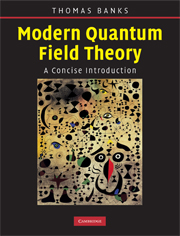Book contents
- Frontmatter
- Contents
- 1 Introduction
- 2 Quantum theory of free scalar fields
- 3 Interacting field theory
- 4 Particles of spin 1, and gauge invariance
- 5 Spin-½ particles and Fermi statistics
- 6 Massive quantum electrodynamics
- 7 Symmetries, Ward identities, and Nambu–Goldstone bosons
- 8 Non-abelian gauge theory
- 9 Renormalization and effective field theory
- 10 Instantons and solitons
- 11 Concluding remarks
- Appendix A Books
- Appendix B Cross sections
- Appendix C Diracology
- Appendix D Feynman rules
- Appendix E Group theory and Lie algebras
- Appendix F Everything else
- References
- Author index
- Subject index
1 - Introduction
Published online by Cambridge University Press: 05 June 2012
- Frontmatter
- Contents
- 1 Introduction
- 2 Quantum theory of free scalar fields
- 3 Interacting field theory
- 4 Particles of spin 1, and gauge invariance
- 5 Spin-½ particles and Fermi statistics
- 6 Massive quantum electrodynamics
- 7 Symmetries, Ward identities, and Nambu–Goldstone bosons
- 8 Non-abelian gauge theory
- 9 Renormalization and effective field theory
- 10 Instantons and solitons
- 11 Concluding remarks
- Appendix A Books
- Appendix B Cross sections
- Appendix C Diracology
- Appendix D Feynman rules
- Appendix E Group theory and Lie algebras
- Appendix F Everything else
- References
- Author index
- Subject index
Summary
Preface and conventions
This book is meant as a quick and dirty introduction to the techniques of quantum field theory. It was inspired by a little book (long out of print) by F. Mandl, which my advisor gave me to read in my first year of graduate school in 1969. Mandl's book enabled the smart student to master the elements of field theory, as it was known in the early 1960s, in about two intense weeks of self-study. The body of field-theory knowledge has grown way beyond what was known then, and a book with similar intent has to be larger and will take longer to absorb. I hope that what I have written here will fill that Mandl niche: enough coverage to at least touch on most important topics, but short enough to be mastered in a semester or less. The most important omissions will be supersymmetry (which deserves a book of its own) and finite-temperature field theory. Pedagogically, this book can be used in three ways. Chapters 1–6 can be used as a text for a one-semester introductory course, the whole book for a one-year course. In either case, the instructor will want to turn some of the starred exercises into lecture material. Finally, the book was designed for self-study, and can be assigned as a supplementary text. My own opinion is that a complete course in modern quantum field theory needs 3–4 semesters, and should cover supersymmetric and finite-temperature field theory.
- Type
- Chapter
- Information
- Modern Quantum Field TheoryA Concise Introduction, pp. 1 - 7Publisher: Cambridge University PressPrint publication year: 2008



